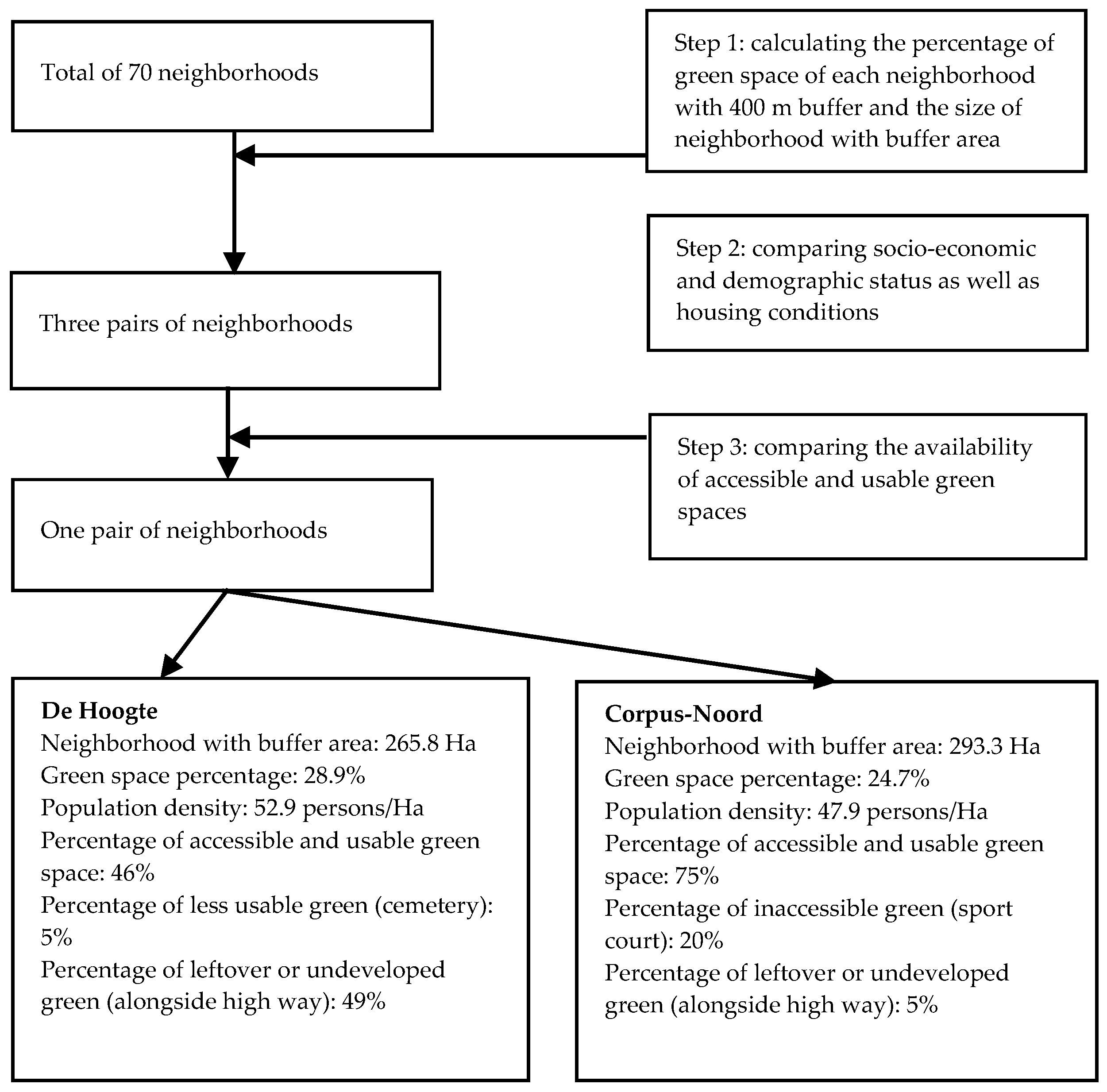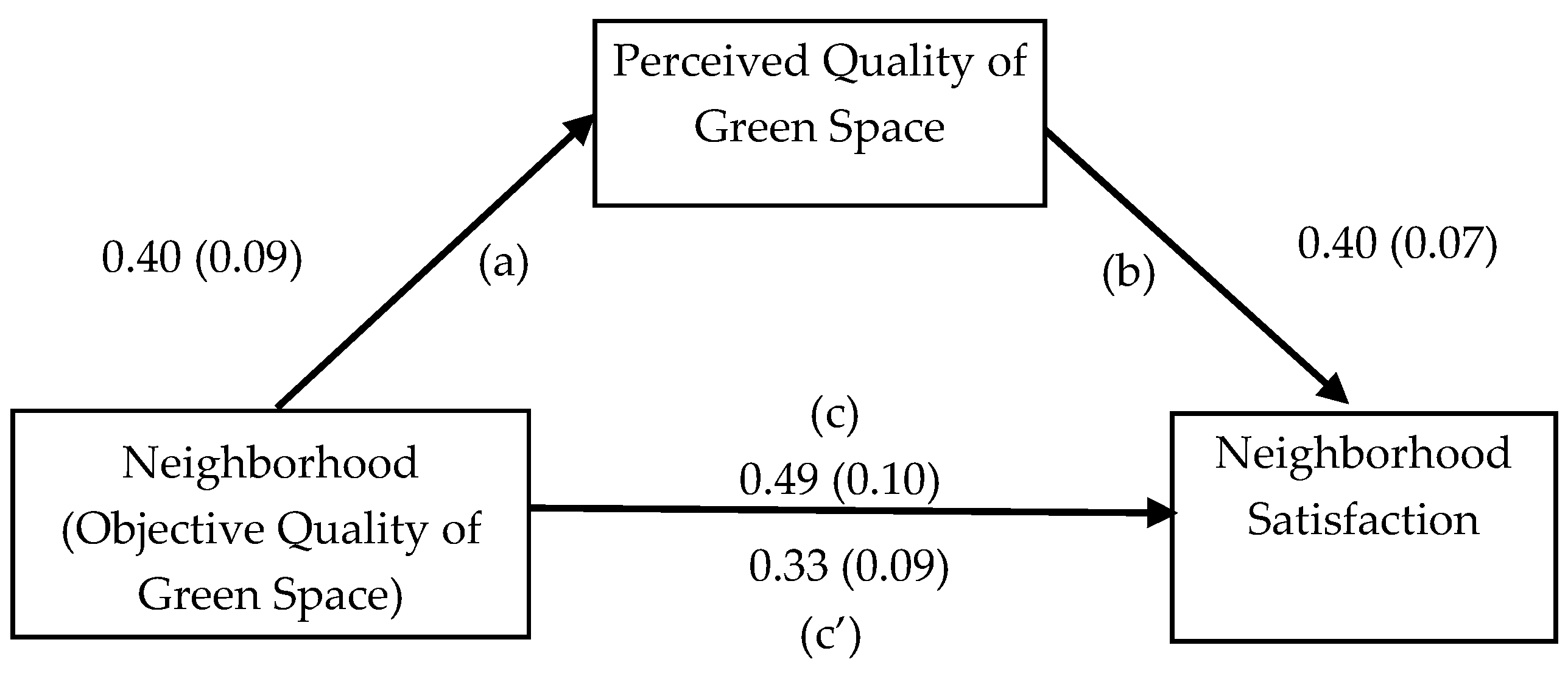Quality over Quantity: Contribution of Urban Green Space to Neighborhood Satisfaction
Abstract
:1. Introduction
2. Methods
2.1. Study Design
2.2. Questionnaire and Measures
2.3. Sample
2.4. Data Analysis
3. Results
3.1. Neighborhood Satisfaction and Overall Well-Being
3.2. Perceived Quality and Beneficial Affordances of Green Spaces
3.3. Mediation Analysis
4. Discussion
4.1. Perceived Green Space Quality and Beneficial Affordances of Green Space
4.2. Neighborhood Satisfaction and Well-Being
4.3. Limitations and Recommendations for Future Study
5. Conclusions
Acknowledgments
Author Contributions
Conflicts of Interest
References
- Van den Berg, M.; Wendel-Vos, W.; Van Poppel, M.; Kemper, H.; Van Mechelen, W.; Maas, J. Health Benefits of Green Spaces in the Living Environment: A Systematic Review of Epidemiological Studies. Urban For. Urban Green. 2015, 14, 806–816. [Google Scholar] [CrossRef]
- Gascon, M.; Triguero-Mas, M.; Martínez, D.; Dadvand, P.; Rojas-Rueda, D.; Plasència, A.; Nieuwenhuijsen, M.J. Residential Green Spaces and Mortality: A Systematic Review. Environ. Int. 2016, 86, 60–67. [Google Scholar] [CrossRef] [PubMed]
- Akpinar, A. How is Quality of Urban Green Spaces Associated with Physical Activity and Health? Urban For. Urban Green. 2016, 16, 76–83. [Google Scholar] [CrossRef]
- Van Dillen, S.M.; De Vries, S.; Groenewegen, P.P.; Spreeuwenberg, P. Greenspace in Urban Neighbourhoods and Residents' Health: Adding Quality to Quantity. J. Epidemiol. Community Health 2012, 66. [Google Scholar] [CrossRef] [PubMed]
- Van den Bosch, M.A.; Östergren, P.; Grahn, P.; Skärbäck, E.; Währborg, P. Moving to Serene Nature may Prevent Poor Mental health—results from a Swedish Longitudinal Cohort Study. Int. J. Environ. Res. Public Health 2015, 12, 7974–7989. [Google Scholar] [CrossRef] [PubMed]
- Zhang, Y.; Van Dijk, T.; Tang, J.; Van den Berg, A.E. Green Space Attachment and Health: A Comparative Study in Two Urban Neighborhoods. Int. J. Environ. Res. Public Health 2015, 12, 14342–14363. [Google Scholar] [CrossRef] [PubMed]
- Hur, M.; Nasar, J.L.; Chun, B. Neighborhood Satisfaction, Physical and Perceived Naturalness and Openness. J. Environ. Psychol. 2010, 30, 52–59. [Google Scholar] [CrossRef]
- Ittelson, W.H. Environmental Perception and Urban Experience. Environ. Behav. 1978, 10, 193–213. [Google Scholar] [CrossRef]
- Agyemang, C.; Van Hooijdonk, C.; Wendel-Vos, W.; Lindeman, E.; Stronks, K.; Droomers, M. The Association of Neighbourhood Psychosocial Stressors and Self-Rated Health in Amsterdam, the Netherlands. J. Epidemiol. Community Health 2007, 61, 1042–1049. [Google Scholar] [CrossRef] [PubMed]
- Guite, H.; Clark, C.; Ackrill, G. The Impact of the Physical and Urban Environment on Mental Well-being. Public Health 2006, 120, 1117–1126. [Google Scholar] [CrossRef] [PubMed]
- Sugiyama, T.; Leslie, E.; Giles-Corti, B.; Owen, N. Associations of Neighbourhood Greenness with Physical and Mental Health: Do Walking, Social Coherence and Local Social Interaction Explain the Relationships? J. Epidemiol. Community Health 2008, 62, e9. [Google Scholar] [CrossRef] [PubMed]
- Marselle, M.R.; Irvine, K.N.; Lorenzo-Arribas, A.; Warber, S.L. Moving Beyond Green: Exploring the Relationship of Environment Type and Indicators of Perceived Environmental Quality on Emotional Well-being Following Group Walks. Int. J. Environ. Res. Public Health 2015, 12, 106–130. [Google Scholar] [CrossRef] [PubMed]
- Ulrich, R.S.; Simons, R.F.; Losito, B.D.; Fiorito, E.; Miles, M.A.; Zelson, M. Stress Recovery during Exposure to Natural and Urban Environments. J. Environ. Psychol. 1991, 11, 201–230. [Google Scholar] [CrossRef]
- Van den Berg, A.E.; Koole, S.L.; Van der Wulp, N.Y. Environmental Preference and Restoration: (How) are they Related? J. Environ. Psychol. 2003, 23, 135–146. [Google Scholar] [CrossRef]
- Maas, J.; Verheij, R.A.; Groenewegen, P.P.; de Vries, S.; Spreeuwenberg, P. Green Space, Urbanity, and Health: How Strong is the Relation? J. Epidemiol. Community Health 2006, 60, 587–592. [Google Scholar] [CrossRef] [PubMed]
- Van den Berg, A.E.; Maas, J.; Verheij, R.A.; Groenewegen, P.P. Green Space as a Buffer between Stressful Life Events and Health. Soc. Sci. Med. 2010, 70, 1203–1210. [Google Scholar] [CrossRef] [PubMed]
- Krekel, C.; Kolbe, J.; Wüstemann, H. The Greener, the Happier? The Effect of Urban Land use on Residential Well-being. Ecol. Econ. 2016, 121, 117–127. [Google Scholar] [CrossRef]
- Larson, L.R.; Jennings, V.; Cloutier, S.A. Public Parks and Wellbeing in Urban Areas of the United States. PLoS ONE 2016, 11, e0153211. [Google Scholar] [CrossRef] [PubMed]
- Arnberger, A.; Eder, R. The Influence of Green Space on Community Attachment of Urban and Suburban Residents. Urban For. Urban Green. 2012, 11, 41–49. [Google Scholar] [CrossRef]
- Korpela, K.M.; Ylén, M.; Tyrväinen, L.; Silvennoinen, H. Stability of Self-Reported Favourite Places and Place Attachment over a 10-Month Period. J. Environ. Psychol. 2009, 29, 95–100. [Google Scholar] [CrossRef]
- De Jong, K.; Albin, M.; Skärbäck, E.; Grahn, P.; Björk, J. Perceived Green Qualities were associated with Neighborhood Satisfaction, Physical Activity, and General Health: Results from a Cross-Sectional Study in Suburban and Rural Scania, Southern Sweden. Health Place 2012, 18, 1374–1380. [Google Scholar] [CrossRef] [PubMed]
- Van Herzele, A.; De Vries, S. Linking Green Space to Health: A Comparative Study of Two Urban Neighbourhoods in Ghent, Belgium. Popul. Environ. 2012, 34, 171–193. [Google Scholar] [CrossRef]
- Vanneste, D. The preservation of nineteenth-century industrial buildings near historical city centres: The case of Ghent. Acta Acad. 2004, 36, 157–185. [Google Scholar]
- Vanneste, D.; Thomas, I.; Goossens, L. Woning en Woonomgeving in België; Sociaal-Economische Enquête 2001. Monografieën nr. 2; Algemene Directie Statistiek en Economische Informatie: Brussels, Belgium, 2007. (In Dutch) [Google Scholar]
- Adjei, P.O.; Agyei, F.K. Biodiversity, Environmental Health and Human Well-being: Analysis of Linkages and Pathways. Environ. Dev. Sustain. 2015, 17, 1085–1102. [Google Scholar] [CrossRef]
- Jim, C.; Shan, X. Socioeconomic Effect on Perception of Urban Green Spaces in Guangzhou, China. Cities 2013, 31, 123–131. [Google Scholar] [CrossRef]
- Gidlow, C.J.; Ellis, N.J.; Bostock, S. Development of the neighbourhood green space tool (NGST). Landsc. Urban Plan. 2012, 106, 347–358. [Google Scholar] [CrossRef]
- Baron, R.M.; Kenny, D.A. The moderator–mediator Variable Distinction in Social Psychological Research: Conceptual, Strategic, and Statistical Considerations. J. Personal. Soc. Psychol. 1986, 51, 1173–1182. [Google Scholar] [CrossRef]
- MacKinnon, D.P.; Fairchild, A.J.; Fritz, M.S. Mediation Analysis. Annu. Rev. Psychol. 2007, 58, 593–614. [Google Scholar] [CrossRef] [PubMed]
- Selig, J.P.; Preacher, K.J. 2008 Monte Carlo Method for Assessing Mediation: An Interactive Tool for Creating Confidence Intervals for Indirect Effects. Available online: http://quantpsy.org/ (accessed on 20 January 2017).
- Leslie, E.; Sugiyama, T.; Ierodiaconou, D.; Kremer, P. Perceived and Objectively Measured Greenness of Neighbourhoods: Are they Measuring the Same Thing? Landsc. Urban Plan. 2010, 95, 28–33. [Google Scholar] [CrossRef]
- Nisbet, E.K.; Zelenski, J.M. Underestimating Nearby Nature: Affective Forecasting Errors Obscure the Happy Path to Sustainability. Psychol. Sci. 2011, 22, 1101–1106. [Google Scholar] [CrossRef] [PubMed]
- Björk, J.; Albin, M.; Grahn, P.; Jacobsson, H.; Ardö, J.; Wadbro, J.; Östergren, P.O.; Skärbäck, E. Recreational Values of the Natural Environment in Relation to Neighbourhood Satisfaction, Physical Activity, Obesity and Wellbeing. J. Epidemiol. Community Health 2008, 62. [Google Scholar] [CrossRef]
- Phillips, D.R.; Siu, O.; Yeh, A.G.; Cheng, K.H. The Impacts of Dwelling Conditions on Older Persons’ Psychological Well-being in Hong Kong: The Mediating Role of Residential Satisfaction. Soc. Sci. Med. 2005, 60, 2785–2797. [Google Scholar] [CrossRef] [PubMed]
- Maas, J.; Verheij, R.A.; de Vries, S.; Spreeuwenberg, P.; Schellevis, F.G.; Groenewegen, P.P. Morbidity is Related to a Green Living Environment. J. Epidemiol. Community Health 2009, 63, 967–973. [Google Scholar] [CrossRef] [PubMed]
- Thompson, C.W.; Aspinall, P.; Roe, J.; Robertson, L.; Miller, D. Mitigating Stress and Supporting Health in Deprived Urban Communities: The Importance of Green Space and the Social Environment. Int. J. Environ. Res. Public Health 2016, 13, 440. [Google Scholar] [CrossRef] [PubMed]


| Variable | De Hoogte (n = 90) | Corpus-Noord (n = 133) | F | p | ηp2 |
|---|---|---|---|---|---|
| Neighborhood Satisfaction (1–5) | 3.39 (0.07) | 3.88 (0.07) | 26.12 | <0.001 | 0.11 |
| Well-Being (Happiness; 0–10) | 7.24 (0.14) | 7.34 (0.11) | 0.34 | 0.563 | 0.00 |
| Green Space Quality (1–5; average score) | 3.21 (0.07) | 3.61 (0.06) | 20.04 | <0.001 | 0.08 |
| Green spaces in my neighborhood | |||||
| 1. contain enough recreational facilities (e.g., play equipment, hard court, grass pitches for football). | 3.10 (0.11) | 3.39 (0.09) | 4.13 | 0.043 | 0.02 |
| 2. provide amenities for sitting, picnic table, litter bins, signs and lighting in the night. | 2.74 (0.11) | 3.37 (0.09) | 18.16 | <0.001 | 0.08 |
| 3. have good natural features such as grass, trees and flower beds. | 3.37 (0.09) | 3.87 (0.07) | 17.71 | <0.001 | 0.08 |
| 4. are absent of incivilities (e.g., general litter, graffiti, dog mess, evidence of alcohol, drug use, broken glass and noise). | 2.95 (0.11) | 3.40 (0.09) | 10.15 | 0.002 | 0.04 |
| 5. are easily accessed, there are many access points and enough walking paths, and roads around are not busy. | 3.64 (0.08) | 3.91 (0.06) | 7.36 | 0.007 | 0.03 |
| 6. are well maintained. | 3.47 (0.11) | 3.73 (0.09) | 3.46 | 0.06 | 0.02 |
| Beneficial Affordances of Green Space (1–5; average score) | 4.00 (0.08) | 3.98 (0.06) | 0.05 | 0.824 | 0.00 |
| Green spaces in my neighborhood | |||||
| 1. promote the quality of life. | 4.12 (0.08) | 4.16 (0.07) | 0.08 | 0.779 | 0.00 |
| 2. promote health. | 4.12 (0.08) | 4.06 (0.07) | 0.37 | 0.544 | 0.00 |
| 3. promote recreational use. | 3.90 (0.10) | 4.01 (0.08) | 0.68 | 0.411 | 0.00 |
| 4. promote social interaction. | 3.86 (0.10) | 3.69 (0.08) | 1.55 | 0.214 | 0.01 |
© 2017 by the authors. Licensee MDPI, Basel, Switzerland. This article is an open access article distributed under the terms and conditions of the Creative Commons Attribution (CC BY) license (http://creativecommons.org/licenses/by/4.0/).
Share and Cite
Zhang, Y.; Van den Berg, A.E.; Van Dijk, T.; Weitkamp, G. Quality over Quantity: Contribution of Urban Green Space to Neighborhood Satisfaction. Int. J. Environ. Res. Public Health 2017, 14, 535. https://doi.org/10.3390/ijerph14050535
Zhang Y, Van den Berg AE, Van Dijk T, Weitkamp G. Quality over Quantity: Contribution of Urban Green Space to Neighborhood Satisfaction. International Journal of Environmental Research and Public Health. 2017; 14(5):535. https://doi.org/10.3390/ijerph14050535
Chicago/Turabian StyleZhang, Yang, Agnes E. Van den Berg, Terry Van Dijk, and Gerd Weitkamp. 2017. "Quality over Quantity: Contribution of Urban Green Space to Neighborhood Satisfaction" International Journal of Environmental Research and Public Health 14, no. 5: 535. https://doi.org/10.3390/ijerph14050535
APA StyleZhang, Y., Van den Berg, A. E., Van Dijk, T., & Weitkamp, G. (2017). Quality over Quantity: Contribution of Urban Green Space to Neighborhood Satisfaction. International Journal of Environmental Research and Public Health, 14(5), 535. https://doi.org/10.3390/ijerph14050535







